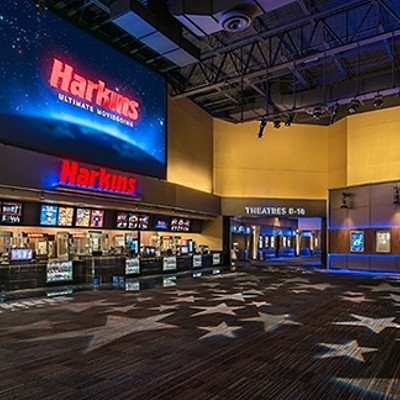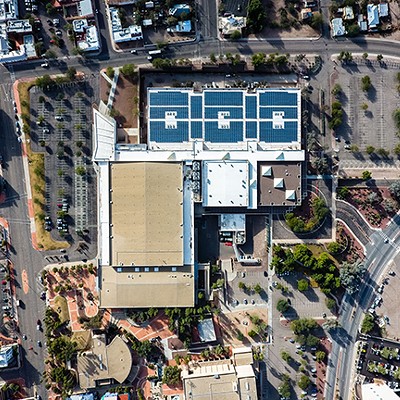Transit advocates say it gives too much money to roads and not enough for buses and light rail. Merchants near a proposed grade-separated intersection at Campbell and Grant fear the two-year construction process will put them out of business. The afternoon daily gripes that Tucson deserves a better plan for its future. Conservatives suggest that if the city did a better job of minding its budget, it wouldn't need to raise taxes.
Even members of the citizen committee that pulled together the plan say they wanted to forge a comprehensive solution to the city's transportation snags, only to realize the city's preferred financing mechanism--a half-cent sales tax--wouldn't produce enough money for grand schemes such as freeways or light rail.
But there's a vision at work, although it's not one the city is touting as it spends more than a million dollars on next month's election.
The two planned grade-separated intersections along Grant Road are the first step in creating a six-lane mini-freeway down Tucson's spine at a cost of hundreds of millions of dollars. If city leaders have their way, over the next quarter-century or so the city will slowly demolish homes and businesses on the north side of Grant Road, install grade-separated intersections at major crossroads and, when possible, shut down cross-streets such as Tucson and Columbus boulevards.
MERCHANTS AND RESIDENTS near the corner of Grant and Campbell are a nervous bunch these days.
Just north of the University of Arizona, the neighborhood features a funky hodgepodge of book stores, restaurants, specialty shops and other assorted outfits, some of which have been operating for decades. It's the south end of a thriving commercial corridor described as a small business incubator by city officials.
With 2001's economic slowdown, many of these business owners have had a rough year. Now the city wants to experiment with a new concept: construction of a grade-separated intersection that would allow Grant Road to run beneath Campbell Avenue. Traffic on Grant would continue unimpeded, while a stoplight on Campbell would allow for left-hand turns and pedestrian crossings.
If voters approve the half-cent tax next month, the city plans to spend $53 million--or about 30 percent of the $180 million dedicated to congestion relief--on just three grade-separated intersections. One would be at Campbell and Grant ($20 million), another at Grant/Kolb and Tanque Verde roads ($23 million) and the third at Kino Boulevard and 22nd Street ($10 million).
Even though the GSI will only demolish a few homes and businesses on the north side of Grant, the proposal has met nearly universal opposition from merchants near the intersection.
"I think it's a ridiculous concept that we spend $20 million on one intersection so traffic can go underneath the road and traffic can go over the road when you basically drive a quarter of a mile in either direction and you hit a stoplight," says Britton Dornquast, owner of Hear's Music.
Dornquast says customers will avoid the corridor during the construction process, which will take at least a year and half. He saw a preview of the impact during a six-week project that put in a right-hand turn lane at Campbell and Grant two years ago.
"My business was off 25 percent for six weeks when they were just knocking out some curbs," he say. "Now they're talking about digging a 25-foot-deep hole in the middle of the intersection."
Dornquast is already bracing for the upcoming widening of Campbell Avenue between Elm Street and Grant Road, a project city officials predict will take a year. But he says that'll be a day at the beach compared to the beating he'll take if the city goes ahead with the grade-separated intersection, which officials estimate will take 18 to 20 months to build.
"It's going to be the guinea pig," Dormquist says. "Like everything else that government does, it's going to take twice as long and cost twice as much. So what will happen is they'll get into that thing and they're saying it's going to be $20 million, so you can pretty much count on it being $30 million."
Dornquast is hardly heartened by promises that city officials will send around a small-business consultant to hand out advice about better marketing while work crews slow traffic along the corridor to a crawl for two years.
The music store owner is not alone in his concerns. Many of his fellow merchants agree that the construction will hammer their businesses.
Dornquast is so dismayed by the proposal that he's joined with Enough!, one of two political committees that oppose the tax. Chaired by Debbie Jordan, who owns a laundromat on Campbell south of Grant, the group includes political activists such as former Ward 6 Councilwoman Molly McKasson, former state lawmaker John Kromko and regular Tucson Weekly contributor Dave Devine.
Mayor Bob Walkup acknowledges that the Campbell corridor is a vital small-business incubator, but says he's obligated to look at the larger picture.
"As mayor and the CEO of the city, I've got a responsibility to the city," Walkup says. "I've got to worry about people getting to and from work. I've got to worry about ambulances and fire trucks and the future of Tucson. So I think my job would be to push ahead in support of transportation planning but see what I might do to mitigate what their specific concerns might be."
SO WHAT IS WALKUP'S long-term vision?
In general, the mayor says he supports a proposal developed by the Pima Association of Governments (PAG) that calls for Grant Road to be widened to six lanes with a series of GSIs. The corridor, says Walkup, will become "an inner-loop parkway that would move east to Kolb and then Kolb to I-10."
"The limited access, high-capacity parkways, where you have an abundance of the free-flowing intersections, can move a lot of traffic," Walkup says. "They are little mini-freeways."
Although the PAG plan calls for just three GSIs, Walkup imagines Grant would burrow beneath most of the larger intersections, such as Campbell, Country Club Road, Alvernon Way, Craycroft Road and Tanque Verde. The outlook for smaller streets, such as Tucson and Columbus boulevards, remains sketchy, but the mayor suggests they may be funneled into a loop road of some kind.
"Would Grant have a lot stoplights?" Walkup wonders aloud. "I think not."
Asked if such a retro-fit plan has worked in other communities, the mayor says it's worked right here in Tucson: "I think Aviation Parkway is a good example of what works."
But there's a major difference between Grant Road and Aviation Parkway: Grant is lined with commercial and residential properties, which means traffic needs to slow for cars that pull in and out of parking lots. It also makes acquiring right-of-way for the project a pricey proposition.
Walkup's fellow Republicans, Fred Ronstadt and Kathleen Dunbar, support the PAG plan. Ronstadt doesn't imagine any problems with having commercial properties alongside a limited-access parkway.
"I think the commercial properties are very compatible with GSIs," says Ronstadt, who suggests that access to the businesses would be handled by "deceleration lanes and the side ramps off, which would accommodate those movements without compromising the flow of the main course of the GSI."
Ronstadt says that widening Grant Road to six lanes will require the city to acquire the property on the north side of the road and demolish it. But even without GSIs, he says, that's the future plan for the corridor.
What's the cost to taxpayers? Ronstadt doesn't know.
But here are some numbers to kick around: The PAG plan estimates widening Grant to six lanes between I-10 and Swan Road is estimated to cost a minimum of $100 million.
Then there's the cost of the grade-separated intersections, which will run an estimated $25 million apiece. A half-dozen would bring the long-term cost of the Grant Road project to $250 million--and that's before inflation raises the cost of right-of-way over the two decades or more before the project is likely to be completed.
If voters approve the sales tax, several elements of the Grant Road project will be under way in the next decade, with an estimated price tag of $73 million (including $63 million from the sales tax and $10 million from Pima County's 1997 bond package). The first two grade-separated intersections will be built along the corridor, at Campbell and Kolb/Tanque Verde for $43 million. The city will widen Grant between Park Avenue and Oracle Road, using $18 million to match the aforementioned $10 million from the county. Another $12 million will be spent on intersection improvements at Grant/Alvernon and Grant/Craycoft that will lay the groundwork for future GSIs.
Where will the future funding for more tunnels and deceleration lanes come from? It's anybody's guess. City officials suggest voters might renew the sales tax in a decade to build more GSIs or the state might provide increased funding.
But it's a safe bet that it will take at least a quarter-century for Grant Road's slow transformation into a mini-freeway--and during the next 25 years, traffic along the corridor will be snarled as construction crews widen the street and dig tunnels through the busiest intersections.
The PAG plan foresees the Grant Road parkway complemented by two other east/west corridors, including the little-used Aviation Parkway (Walkup and others remain confident drivers will eventually discover the road) and Valencia Road. North-south corridors will include Houghton, planned to go from its current two lanes to four or six lanes, and Kolb Road, as well as possibly Campbell, First Avenue or Oracle Road. The long-range cost? No one knows for sure.
THE CITY CHARTER'S Neighborhood Protection Amendment, passed by a narrow majority of voters in 1985, was designed to stop the city from undertaking these kinds of projects without specific approval from Tucson voters.
Created by an initiative campaign spearheaded by political gadfly John Kromko, the amendment requires voter approval before GSIs and freeways can be built. Kromko pushed for the law after seeing city residents fighting against a series of highway plans that would have destroyed historic neighborhoods.
"We did the Neighborhood Protection Amendment so people could see what it was going to be because we figured they'd lie about how disruptive these projects were going to be," the former state lawmaker remembers. "I think it's very reasonable for residents and businesses around the intersection to see it."
The Neighborhood Protection Amendment, along with a tight budget, has kept city officials from pushing for GSIs, with the exception of a project at Grant and Campbell as part of the 1990 half-cent sales tax election that was shot down by voters.
The intersections re-emerged with little public debate late last year when the citizen committee that developed the blueprint for the proposition forwarded its recommendation to the council.
To accommodate the Neighborhood Protection Amendment, city attorneys included a provision in the language of Prop 400 that approval of the plan would satisfy the requirements of the Neighborhood Protection Amendment.
Kromko said bundling the GSIs in with the rest of the package violated the provisions of the Neighborhood Protection Amendment, which requires the city to ask voters to approve or reject the specific structures after they've been presented with the design and cost on the ballot. He joined with Grant Road homeowner Susan Chambers Casteloes, Campbell Avenue business owner Debbie Jordan and graphic designer Andy Mosier to sue the city in February, saying the city's proposal violated the NPA.
Last month, Superior Court Judge Ted Borek ruled that the election could proceed, but expressed concern that the city could be violating the Neighborhood Protection Amendment. Saying the case would be moot if the voters rejected the proposal, Borek told the plaintiffs to come back after the election if they wanted to pursue their case.
The group plans to take the city back to court if the transportation plan passes, but the outcome of that fight is far from certain. Ronstadt has suggested the city may argue that the Neighborhood Protection Amendment is unconstitutional. If the judge agrees, the city would eliminate a major element of voter input into the city's transportation future--as well as a thorn in the transportation department's wheels.
The transportation department planners insist even a single GSI would improve traffic flow. Jim Glock, a deputy director in the transportation department, says the signals increase "green time," as transportation professionals refer to the period drivers can move through intersections. More green time decreases the time cars spend idling, cutting down on pollution, and reduces the noise from braking and accelerating. Neighbors see fewer impatient drivers trying to find shortcuts on residential streets. And, because Tucson's grade-separated intersections will take one street underground, no unsightly overpass spoils mountain views.
But many critics don't believe the intersection will significantly decrease congestion until there's a very expensive string of them.
"Unless you do a whole series of GSIs at $30 million a pop, you just move the problem one intersection over," says Steve Farley, a mass-transit advocate. "It's insanity. For that price, you could get an excellent light rail line."
Farley is leading an initiative drive for an alternative ballot proposal that would impose a lower sales tax rate of one-third of a cent and increase the tax on construction materials. The plan would dedicate more money to residential streets and mass transit, including light-rail lines down Broadway and South Sixth.
Even supporters of the city's sales tax are skeptical of the GSIs.
"All you do is eliminate one stoplight in one direction," developer Bill Estes Jr. told The Weekly last year. "You still have all the side streets, all the businesses, so people will still be slowing down." And, he adds, the intersections are "going to bankrupt all the businesses on that corner because their customers are not going to be able to get to them."
The merchants along Campbell Avenue don't appreciate being the guinea pigs for the city's transportation experiment, especially given that the delay at the intersection isn't even among the top 10 in Tucson.
At Hear's Music, Dornquast dismisses the GSIs as a "half-assed, Band-Aid solution."
If the city is going to spend that much money, says Dornquast, they might as well just build a freeway through town. The current plan takes too long, costs too much and even when it's finished, it won't allow for freeway speeds. His pick for a location is along the Rillito-Pantano corridor.
Down the street at Plaza Liquors, owner Mark Thompson has been studying the GSI for more than a decade. He was once a big proponent of the plan, but now thinks Campbell and Grant is the wrong place for that kind of intersection.
"An interchange at Grant and Campbell right now would just be crazy, especially if Campbell between Grant and Glenn stays the way it is," says Thompson. "Then they're going to be pouring North Campbell over the interchange into a bottleneck area.
"The interchange is not going to work unless you widen Campbell," says Thompson. "And once you widen Campbell, that really does threaten a lot of the integrity of what Campbell is right now, which is a place with a lot of independent businesses that people come from around the city to shop."
Roger Sliker, who owns the Raging Sage coffeehouse, says the construction will likely force him to move. "People will not wait a long time in very confusing and unpredictable construction traffic to go for a cup of coffee," says Sliker. "That's what we call destination delayment."
Sliker would like to see a transportation plan that has more money for mass transit and less for roads, which he says leads to more sprawl. He says the city's GSI plan is foolhardy, which makes his potential future especially frustrating.
"I don't agree with the transportation plan in the first place," Sliker says, "so I don't see us sacrificing business as being part of a grand plan to make Tucson a better place."















